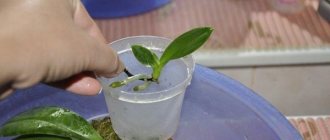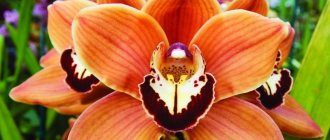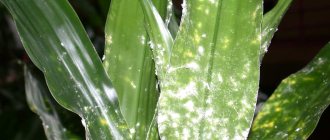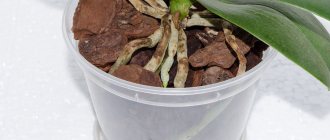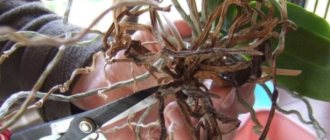How to understand that the root system is not functioning?
Phalaenopsis is a fairly viable plant, so you may not suspect that something is wrong with it for a long time. If you notice any changes in the condition of the flower, for example yellowed leaves, you should remove it from the flowerpot and inspect the root system.
Living and healthy roots should be green or white; if there is not enough light, they can be brownish, always hard and dense to the touch, while rotten roots crumble under your fingers and become hollow. If you press on them, moisture will be released, and if the situation is completely advanced, they will crawl under your fingers. In this case, the root system can no longer be saved.
“Phalaenopsis without roots” is a plant falling apart with a dying bottom and a few leaves near the growing point. It is necessary to immediately cut off everything that has rotted and dried out, and begin resuscitation of the flower.
Why might this situation arise?
Too much watering. The most common cause of root rot. In conditions of constant humidity and poor ventilation, velamen - the tissue that covers the roots - begins to rot and over time this process spreads to the entire root system.- Lack of lighting. An orchid needs light for photosynthesis; without it, the flower cannot form new cells, which means it stops developing, almost stops absorbing moisture, and its roots begin to die.
- Hypothermia. If the temperature drops, the process of absorption of moisture from the substrate is disrupted, which is why the flower receives a cold burn and the root cells die.
- Chemical burn. Too much concentration of fertilizer, watering fertilizer on dry soil, and applying fertilizer too frequently can burn the delicate root system.
- Diseases. If the orchid's soil was first dried out and then flooded, an infection may occur, and first the leaves of the plant will become limp, and later the roots will begin to die.
- Unsuitable substrate. Under no circumstances should you grow an orchid in ordinary soil - the roots will rot due to lack of air. Hydrogel or sphagnum as the main substrate can also only harm the plant’s root system if watering is incorrectly calculated.
- Lack of moisture and heat. This dries out the plant's roots.
- Hard and salty water. Such water cannot be used for irrigation; it has a bad effect on the general condition of the phalaenopsis and its root system in particular.
Symptoms and causes of the disease
Accurate knowledge of the causes of flower disease will help you understand how to save the orchid and provide it with proper care.
Orchid diseases:
- Problems with flowering. There are three main ones:
- doesn't bloom
- buds may wither or rot,
- Dark spots appear on the flowers.
A healthy orchid in the right conditions
- Various rots:
- Brown bacterial. In this case, the leaves begin to rot.
- Rotten roots. In most cases a transplant will be required.
- The leaves may rot and become covered with a gray or black coating - this indicates the presence of fungi.
- Fusarium rot - leaves begin to turn yellow.
- Leaf diseases:
- Anthracnose. The leaves are infected by a fungus and become covered with small black spots. This happens due to stagnation of water in the leaf axils.
- Bacterial spotting. First, the leaves turn yellow, then they can rot, then they soften, crack, and can dry out and fall off.
- Leaf deformation, lost turgor.
- Leaf burn. Often occurs in the summer. If you do not put the orchid in the shade in time, the leaves will die very quickly, forming holes at the burn sites.
- Powdery mildew. The plant becomes covered with a white coating and will soon die if no action is taken.
- Viral diseases. They do not manifest themselves for a long time, cannot be treated, and the flower will have to be destroyed.
Important! As soon as a virus is detected in an orchid, it should be immediately removed from other plants and destroyed. If watering is common in one container, then other flowers are probably infected. In this case, they must be treated with antibiotics.
The causes of diseases can be:
- A virus or fungus can be introduced using tools.
- Overheat.
- Over or under watering.
- Incorrect amount of feeding.
- Parasites, insects in the soil.
- The substrate has not changed for a long time.
- Bad light.
What will you need for this?
How to save your favorite plant?
It is necessary to carefully remove the orchid from the flowerpot.- Remove remaining soil from the root system by washing it in warm water.
- Carefully examine the roots and cut off all rotten and dried areas, leaving only healthy roots (read about why roots, leaves and other parts of the plant dry here).
- Cut off flower stalks, as they take a lot of strength from the plant.
- If there are rotten or dry spots on the leaves, cut to healthy tissue.
- Treat the cut areas with crushed charcoal or activated carbon or cinnamon.
- For additional prevention of the development of fungal diseases, you need to soak for 15 minutes in a solution of fungicides, reducing the dosage by 2 times.
- Dry the flower for half an hour to 4 hours, you can leave it for a day.
For successful resuscitation, phalaenopsis needs a sufficient amount of light, so in winter it is necessary to use a phytolamp.
What measures are taken to save orchids?
Once the cause of leaf fall is determined, it is easier to choose a method to resuscitate the entire stem. Sequentially proceed to the following activities:
- remove the flower from the planting site;
- remove damaged areas of rhizome;
- treat the cut with an antiseptic;
- change the substrate;
- transplanted into another soil;
- create all conditions for further maintenance.
Remaining in unfavorable conditions for any plant means death. Exotic flowers are especially demanding of normal maintenance.
Temperature compliance
There should be no temperature changes in the room where the flower is located. The pot should not be placed near hot radiators; the sprout should not be exposed to cold air currents or drafts. Roots and leaves suffer from overheating. The soil quickly dries out, begins to compress the stem, and the juices stop performing their normal cycle. But in the summer, it is imperative to ventilate the room; the pot is placed so that direct rays do not fall on the peduncle. If overheating occurs, wrap the container where the plant is planted with a wet cloth.
Lighting order
Each type of orchid loves light in its own way. Excess sun can burn the leaves; too little will cause the trunk to stretch toward the light source. Over time, the plant will lose strength when fighting for ultraviolet radiation and may die. It is especially dangerous for orchids in the back of the room or on northern window sills. Wherever the flower is located in winter, it will lack light and will have to resort to fluorescent lamps.
Fungal formations
Plants suffer from various fungal diseases, which are reflected by the appearance of the green mass, where spots and plaques appear on the surface. Favorable soil for the development and spread of fungus in any form becomes:
- waterlogged warm soil, improper watering;
- poor air circulation in the flowerpot;
- oversaturation with nitrogen.
If the root:
- clean off affected areas;
- lubricate with fungicide;
- dry;
- replant into renewed soil - the plant will recover.
You can save foliage from death by preventing negative formations. Organizing proper care will restore the beauty of flowering, help revive greenery, and restore the root system.
Step-by-step instructions on how to root
In the greenhouse
You can purchase a ready-made greenhouse or make one yourself. A plastic bottle, an aquarium, a plastic bag with a zipper, or a plastic cake box are suitable for this.
- Expanded clay should be poured into the selected container, with moist but not wet sphagnum moss on top of it.
Important! It is necessary to use this particular type of moss due to its bactericidal and disinfectant properties. - Place phalaenopsis on top of the moss.
- Next, it is necessary to provide abundant and diffused lighting and an air temperature of +22-25 degrees. At lower temperatures, the humidity level will increase, which will provoke the appearance of mold and prevent the plant from growing new roots. If the temperature is higher, the flower will burn and will not absorb, but evaporate moisture, which also does not promote root growth.
- While growing the root system, the greenhouse must be ventilated every day in the evening or at night. In winter, 20 minutes will be enough. In summer it is better to leave the greenhouse open until the morning.
It is important to periodically inspect areas of contact with moss for darkened, water-filled areas. If they are detected, it is necessary to dry the phalaenopsis outside the greenhouse and put it back on the other side.- To stimulate root growth, fertilizing should be done every 10-20 days. The most suitable microfertilizer is iron chelate.
- Once a month you need to use growth stimulants such as Epin or Zircon.
- To maintain the elasticity of the leaves, you need to rub them with a solution of sugar or honey at the rate of 1 teaspoon per liter of water.
We invite you to watch a video about resuscitating an orchid without roots using a greenhouse:
At home
Alternating soaking and drying
- For this method, you need to select a transparent container in which the base of the orchid will freely fit and place the plant in it so that the base of the root is slightly higher than the bottom.
- Every morning you need to pour a little warm (approximately +24-25 degrees) water so that the base is slightly immersed in it, and after 4-6 hours, drain it and dry the orchid until the next morning. Lighting should be plentiful, but it is necessary to exclude the possibility of direct sunlight.
Important! Glucose, sugar or honey should be added to the water daily (1 teaspoon per liter of water), and potash, phosphorus fertilizers and root vegetables should be added once every 2-3 weeks.
Leaf Dipping
When using this method, it is not the base that needs to be immersed in water, but the leaves of the phalaenopsis.
- It is necessary to fill the container with water with the addition of crushed coal and immerse the straightened leaves of the plant into it by a third.
- The roots left exposed to the air must be sprayed daily with water with the addition of succinic acid or vitamin B, and a root growth stimulator should be used from time to time.
- After the first roots appear, you need to place the plant in a transparent pot with sphagnum moss.
Building in water
To do this, you need to immerse the phalaenopsis in a solution of warm filtered water with the addition of Kornevin, iron or glucose chelate, which should be changed every 5 days.
This method is the least suitable for orchids, since the roots grow slowly, they often rot and do not take root well in the substrate.
In the video you can see the method of resuscitating an orchid in water:
Reanimation of an orchid above water
To do this, you will need a transparent container and cool boiled water.
- You need to place the phalaenopsis above the water so that it does not touch it, and place the container in a well-ventilated place with an air temperature of at least +23 degrees.
- It is necessary to wipe the leaves of the plant from time to time with a solution of succinic acid and ensure that the water does not evaporate completely.
Reference! This is a simple and effective method, good for beginners.
Video about resuscitation of an orchid without roots above water:
Resuscitation at home
Reanimating an orchid at home requires a lot of patience and painstaking care for the plant. It is imperative to prepare all the conditions for reviving the flower and further maintenance.
Additional Information. When there is too much light, the plant's leaves turn bright green. Diminish the amount of light until the leaves turn pale green again.
Conditions of detention
Phalaenopsis requires the following maintenance conditions:
- Lighting – diffused, without bright sunlight.
- Temperature – avoid drafts and air conditioning.
- Humidity – 60-70%.
- Watering is regular. You can’t overfill a flower or place a pot with a plant in a basin of water for 25-30 minutes 1-2 times a week.
- The right soil. You can buy soil at the store and add pieces of expanded clay, oak bark and charcoal to it.
- Feeding. Fertilizers should contain nitrogen, phosphorus and iron.
Note! The most difficult period for phalaenopsis is autumn-winter. The air temperature drops significantly outside, causing the heating to turn on at home. In this case, the temperature in the rooms rises, the air becomes less humid. Also, the color day is shortened, so the orchid receives less sunlight.
Conditions for recovery
In order for the orchid to recover without problems, the following conditions must be observed:
- Watering must be very careful.
- You should not fertilize the flower for about a month after “revival” to avoid a negative reaction. Afterwards, introduce fertilizing gradually.
- Control the presence of pests.
- Use only high-quality substrate.
- Maintain comfortable living conditions for the orchid.
How to speed up the process?
All the described methods of resuscitating phalaenopsis take quite a lot of time; to stimulate this process you can:
- Wipe the leaves and mix a solution of succinic acid into the water at the rate of 4 tablets per liter of water.
- Dilute one ampoule of vitamins B1, B6 and B12 in a liter of water and lower the part of the orchid from which the roots will grow into the solution, leaving it overnight.
- Feed the plant daily with glucose, sugar or honey.
- Feed with iron chelate every 2-3 days, and fertilizers containing potassium and phosphorus - once every 20 days.
It is necessary to alternate feedings, otherwise you may not notice that some of them are ineffective and the plant will die.
When to plant a plant in the ground?
Phalaenopsis can be replanted into the substrate only after the roots have grown at least 3-5 mm.
- To do this, you need to take a flowerpot no more than 8 cm in diameter so that the plant quickly absorbs water and dries quickly.
It is better to use a peat pot, then in the future you will not need to completely replant the plant, but only move it to a new pot and add substrate. - When the roots become 7-8 cm long, it is necessary to transplant the phalaenopsis into a larger pot and secure it on a support.
There are several diseases that can greatly harm an orchid. They are mainly caused by either improper care or pests. To avoid wilting of flowers and buds, sticky plaque and other problems with leaves, you need to follow preventive measures and inspect the flower.
Aftercare
When the plant grows roots and gains turgor, it is necessary to accustom it to dry air after greenhouse conditions. To do this, you will need a new greenhouse made from a transparent bag or the bottom of a plastic bottle. It is necessary to put it on the plant for 5-6 hours a day so that there is 10 cm to its bottom from the tips of the leaves.
After a few weeks, phalaenopsis fully adapts.
Do not rush to part with the flower even if it has lost all its roots - just choose the most suitable method of growing a new root system, follow the instructions and the phalaenopsis will recover and begin to delight with its flowering again.
Choosing an environment
The growth of new roots in an orchid can be done in different environments; sphagnum moss, a mixture of moss, vermiculite and bark, and water are suitable for this. It may not always be possible to grow quickly, but there is definitely no need to rush to say goodbye to the orchid.
Some gardeners place the plant on a mixture of moss, vermiculite and bark, with the plant only touching the moss and the vermiculite lying underneath. You can put an orchid on such a pad in a greenhouse so that the humidity is increased and the roots grow in an environment close to their native one. You can attach a glass aquarium or a plastic bottle with the top cut off under the orchid greenhouse. Every day you need to take the orchid out to air it in the fresh air for 15–20 minutes, and then place it back in the greenhouse.
Experienced gardeners root epiphytic orchid species on blocks without watering at all. They clean the plant of all affected roots, treat the cut areas with an antiseptic, dry it, moisten the place from which new roots should grow with a solution of some rooting agent, and then attach the plant to a block. The only condition is that the room must always maintain sufficient humidity.
The most commonly used method is to grow Phalaenopsis roots in water, or more precisely, above water. This is considered to be the easiest method, and it is recommended for beginners to use.
